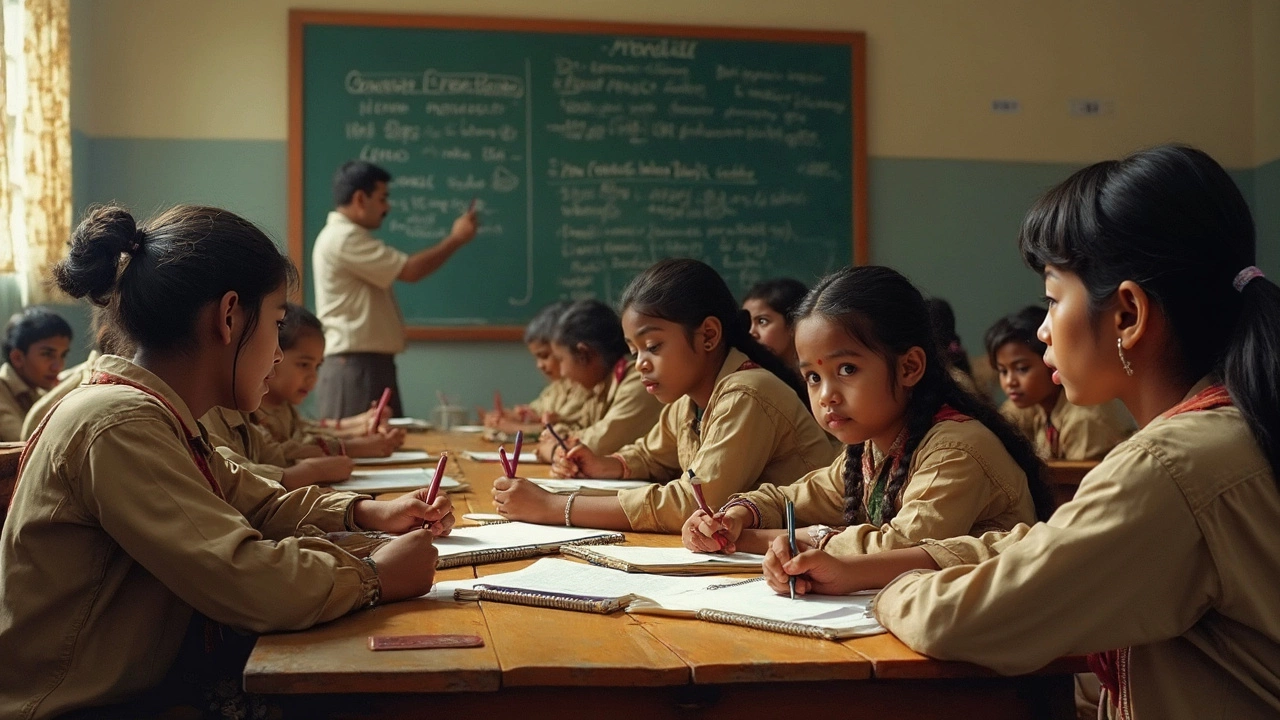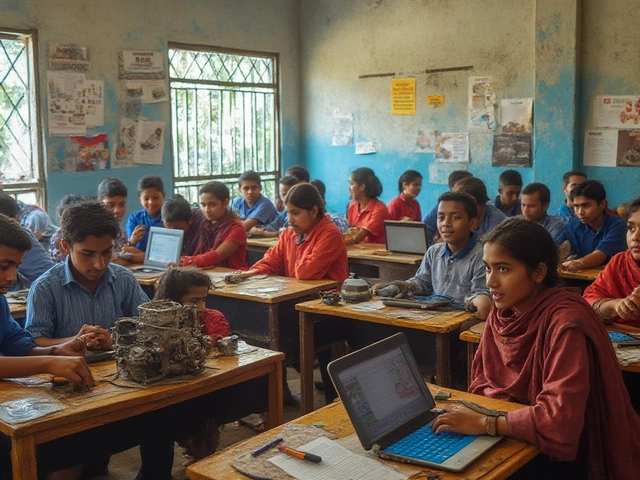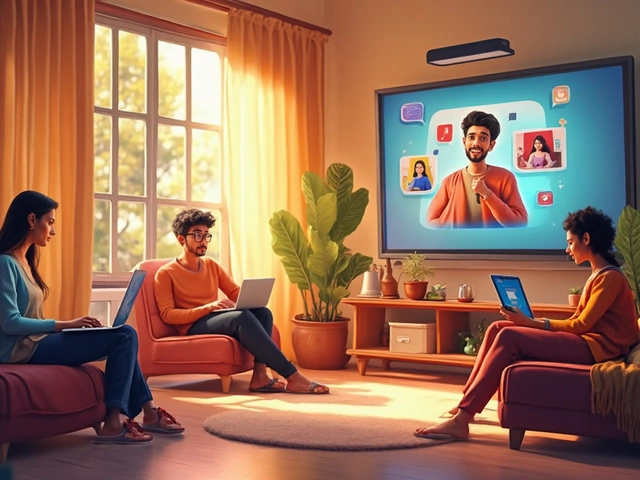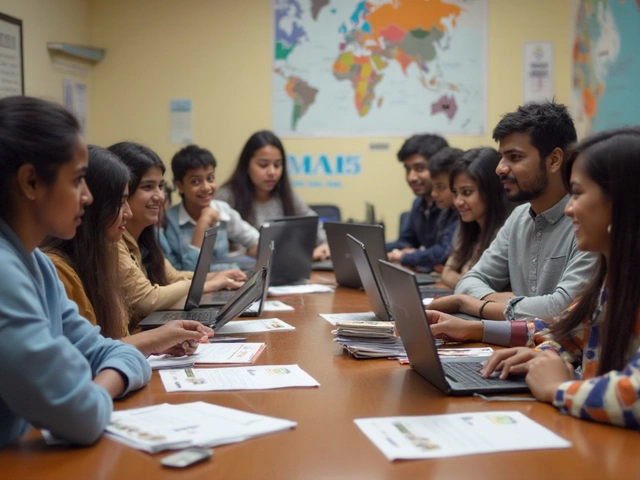Feb
13

- by Dhruv Ainsley
- 0 Comments
When it comes to choosing between Dubai and India for their child's education, many parents find themselves weighing the pros and cons of these two vibrant yet different systems. The CBSE syllabus, while originating in India, is taught in many schools across Dubai, but how does it really stack up?
First off, let's talk about structure. Dubai schools offering CBSE tend to showcase a blend of modern teaching techniques with traditional values. But here's something interesting: they often have smaller class sizes, which means more individual attention for students. In India, despite the rigorous CBSE curriculum, crowded classrooms can sometimes make personal attention a luxury.
Then there's the curriculum. In Dubai, schools often incorporate international elements into the CBSE framework, offering students a more global perspective. Whereas in India, the focus is heavily on achieving academic perfection. This can make a big difference in terms of student stress levels and overall learning experience.
- Overview of Dubai and India's Education Systems
- CBSE in Dubai vs. India
- Curriculum and Teaching Methods
- Student Performance and Assessments
- Multicultural Environment in Dubai
- Choosing the Right Educational Path
Overview of Dubai and India's Education Systems
You might be wondering if sending your kid to a school in Dubai or sticking to one in India is the way to go. Both places have their own unique approaches to education. Let's break it down a bit.
Dubai’s education system is quite cosmopolitan. There are schools offering various curriculums from around the world—British, American, International Baccalaureate (IB), and of course, CBSE. The multicultural environment means kids are often exposed to diverse cultures and ideas early on. It's not just academic learning; there's a significant focus on cultural acceptance and understanding.
On the other hand, India’s education system is largely driven by standard national curriculums like CBSE and ICSE, with CBSE being the more popular choice. The focus here is definitely more on academic rigor and creating a strong foundational knowledge base in subjects ranging from science to arts. Plus, India’s education system is known for its competitive spirit, all the way from local exams to the national level.
Infrastructure and Resources
Dubai schools often have cutting-edge facilities with tech-enabled classrooms, promoting a more interactive learning environment. In India, while urban areas see well-equipped schools, rural regions sometimes lag in infrastructure, affecting quality education access.
Teacher Qualifications
Another angle to consider is the teachers. In Dubai, many educators are expats with international experience, which can give students a broader perspective. In India, being a teacher is a highly respected profession. Teachers often have deep subject knowledge and a passion for shaping young minds, although more professional development opportunities are needed to keep up with global trends.
To sum it up, choosing between Dubai and Indian schools involves looking beyond just academics. It's about the overall experience, from the style of teaching to the cultural vibes. Each system comes with its strengths, catering to different needs and aspirations of students and parents alike.
CBSE in Dubai vs. India
Both Dubai and India offer the CBSE curriculum, but the experience in each location can be quite different. In Dubai, schools often place a strong emphasis on a global outlook, integrating international elements into the syllabus. It's not just about textbooks and exams; it's about preparing students for a world that's increasingly interconnected.
One remarkable aspect is the teaching approach in Dubai. Teachers are encouraged to use modern methods such as project-based learning and digital tools to make classes interactive. According to a study conducted in 2024, students in Dubai had more access to technology in classrooms, with over 80% of CBSE schools using smart boards regularly.
Student Support and Guidance
In Dubai, there's a noticeable focus on student well-being. Schools often include counseling and support as part of their offerings. A quote from Dr. Amal Al-Qassab, an education consultant, sums it up well:
"The education system in Dubai is not just about grades; it's about nurturing young minds to be well-rounded individuals ready for future challenges."
In contrast, Indian CBSE schools are traditionally result-driven. Many schools emphasize high academic achievement as a gateway to entrance exams for prestigious universities. While this has created a competitive spirit, some argue it could lead to increased stress among students.
Cultural and Environmental Differences
In terms of environment, studying in Dubai can be a multicultural experience. Students from various backgrounds learn together, which enriches their understanding of different cultures. On the flip side, India offers a deep dive into rich traditions and values intrinsic to the Indian way of life.
Performance and Outcomes
Performance-wise, students from both locations tend to excel in the CBSE exams. However, Dubai students often have an edge in extra-curricular achievements. In a 2023 international school competition, a team from a Dubai CBSE school bagged the top prize in a tech innovation challenge, showcasing their practical skills and creativity.
Curriculum and Teaching Methods
When diving into the curriculum and teaching methods in Dubai versus India, there are some notable differences to point out, especially when talking about the CBSE syllabus. Both are comprehensive, but how they are implemented varies greatly.
Flexibility and Adaptation
In Dubai, the CBSE curriculum is often infused with a dose of flexibility. Schools here tend to adopt an international outlook, blending the rigorous content of CBSE with global perspectives. This means lessons may include contemporary global issues, practical experiments, and a lot more interactive learning, which isn't always the norm in Indian classrooms.
Teaching Style
Teaching methods in Dubai are generally more student-centric. Teachers often use modern tools like smart boards, digital resources, and even virtual reality to make topics come alive. This tech-savvy environment helps in engaging students more effectively compared to many traditional methods observed in India.
Assessment Techniques
Another interesting aspect is assessment. In Dubai, assessments often revolve around projects and practical knowledge, whereas in India, exams and rote memorization can still be predominant. This has been shifting in recent years, but the emphasis on holistic education is stronger in Dubai.
Language and Cultural Integration
The multicultural milieu of Dubai also plays a role in curriculum delivery. Language skills here often get a significant boost due to the diverse student population and the need to communicate in a multi-lingual environment.
| Aspect | Dubai | India |
|---|---|---|
| Class Size | Typically smaller | Larger |
| Learning Tools | Advanced tech usage | Traditional, with increasing tech |
| Focus | Global perspective | Academic perfection |
In conclusion, both systems have their highs and lows, and choosing one often depends on what you prioritize for your child's education. Whether it's the global exposure of Dubai education or the rigorous academic challenge in India, there's no one-size-fits-all answer.

Student Performance and Assessments
When it comes to gauging student performance, both Dubai education and India's CBSE system have their own set of criteria and approaches. Let's dig a little deeper into how each handles assessments and what it means for students.
In Dubai, schools tend to offer a more holistic approach to assessments. While exams remain important, there's a significant emphasis on projects and practical work. This gives students a chance to demonstrate their understanding beyond scores, nurturing skills that go beyond textbooks. A variety of co-curricular activities are often included, which can impact overall grades positively, emphasizing a well-rounded education.
On the flip side, the CBSE system in India leans heavily on exam performance. For many students, exams are the primary measure of success, and this high-stakes environment can be both motivating and, at times, nerve-wracking. Continuous assessments, though present, carry less weight compared to the final exams.
Grading Systems
Dubai schools, following the CBSE syllabus, incorporate a mix of grades, but they often include international grading standards, which can sometimes confuse parents new to the system. In India, the grading system is straightforward, with clear cut-offs for understanding where a student stands.
| Aspect | Dubai | India |
|---|---|---|
| Focus on Exams | 40% | 70% |
| Project Work | 30% | 10% |
| Co-curricular Impact | 20% | 5% |
| Other Assessments | 10% | 15% |
For students who excel in interactive learning and prefer hands-on experiences, Dubai might offer an edge. However, those who shine in written exams may thrive in the Indian system.
In choosing between these educational paths, it's crucial to consider what kind of learner your child is and what environment they are likely to succeed in. Both have their perks, and understanding these differences can help in making an informed decision.
Multicultural Environment in Dubai
Dubai is basically a melting pot of cultures. It's not uncommon to find classrooms filled with students from all over the globe. This mix can offer a unique learning atmosphere that's very different from classrooms in India. In Dubai, students are often exposed to a range of perspectives that just aren't as prevalent back home.
The Classroom Experience
Imagine sitting in a classroom where your classmates bring in stories and customs from various corners of the world. It sounds exciting, right? That's the norm in many Dubai schools. While the core CBSE curriculum remains the same, the way students interact and learn can significantly differ, thanks to these multicultural dynamics.
One key benefit is that students develop a level of cultural sensitivity and awareness early on. This not only enriches their educational experience but also prepares them for life in an increasingly globalized world.
Networking Opportunities
Another cool aspect is the networking opportunities. Being surrounded by peers from different nations can lead to lasting friendships and professional contacts across borders, which is a unique perk you might not get in typical Indian classrooms.
Tolerant Learning Environments
With diversity comes a higher level of tolerance. Schools in Dubai often promote campaign days, themed weeks, and other activities designed to teach children about the cultures and traditions of their classmates. It's not just about learning; it's about understanding and respecting others.
| Nationalities | % in Schools |
|---|---|
| Indian | 25% |
| European | 20% |
| Middle Eastern | 15% |
| Asian (Non-Indian) | 20% |
| African | 10% |
| Others | 10% |
The stats above give a snapshot of the variety you might find in a typical classroom. The Indian presence is strong due to many expat families, but there's a significant representation from Europe, Asia, the Middle East, and other regions too.
Choosing the Right Educational Path
Deciding whether to pursue an education in Dubai or India can feel like a tough call. Both places have unique strengths, especially when dealing with the CBSE syllabus. Here’s a rundown of what you should consider to help your decision-making process.
Consider Your Child’s Needs
Every child is different. Some students thrive in a competitive environment, which is often the norm in Indian schools due to high emphasis on academic excellence. Meanwhile, others might benefit from the diverse and multicultural environment found in Dubai, where they can gain a global perspective and get exposure to varied cultures and ideas.
Look at Extracurricular Opportunities
Education isn’t just about academics. Assess what extracurricular activities are offered. Schools in Dubai often provide a wide array of options, from sports to art and technology clubs, thanks to their international outlook. This isn’t to say that Indian schools lack these, but the variety might be more limited depending on the region.
Factor in Long-Term Goals
Think about what opportunities either location might offer for your child's future. Schools in Dubai, with their strong international ties, can provide pathways to global universities, which might be appealing if you see them pursuing education abroad. On the other hand, graduating in India can offer robust connections within the Indian higher education and professional landscape.
Consider Financial and Logistical Aspects
Let's not forget about the practical side. Education costs can vary significantly between Dubai and India. While Dubai offers a high standard of living and education, it comes with a price tag. Assess what fits your financial situation. Also consider logistics like housing, language, and adjusting to a new culture if you’re thinking of moving.
| Aspect | India | Dubai |
|---|---|---|
| Class Size | Larger | Smaller |
| Teaching Methods | Traditional | International/Modern |
| Cost | Lower | Higher |
| Environment | Local | Multicultural |
No choice is definitively better; it depends on what aligns best with your priorities and your child’s needs. Weigh these factors carefully, and whatever path you choose, ensure it nurtures their growth and future success.





